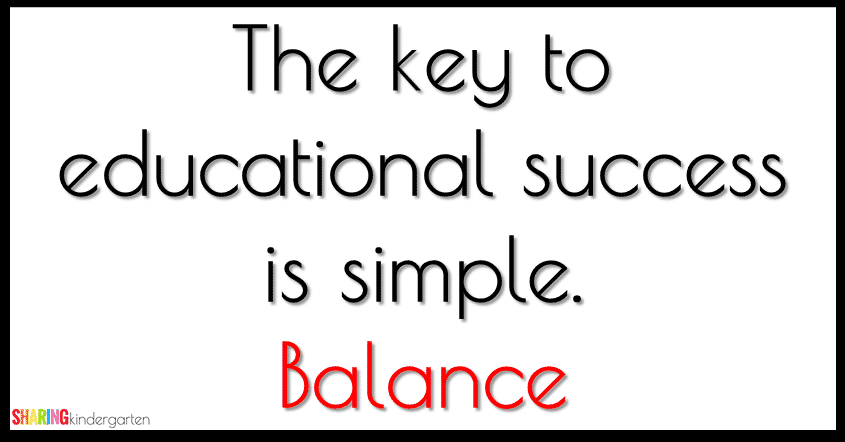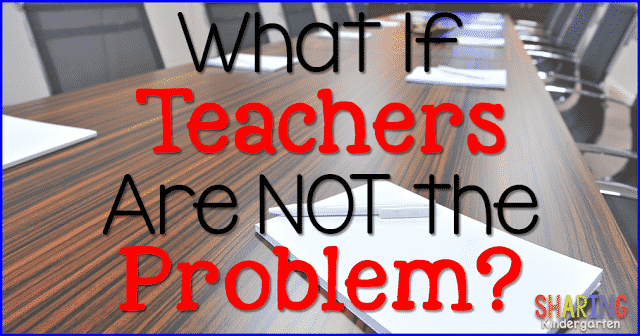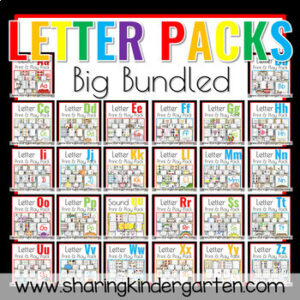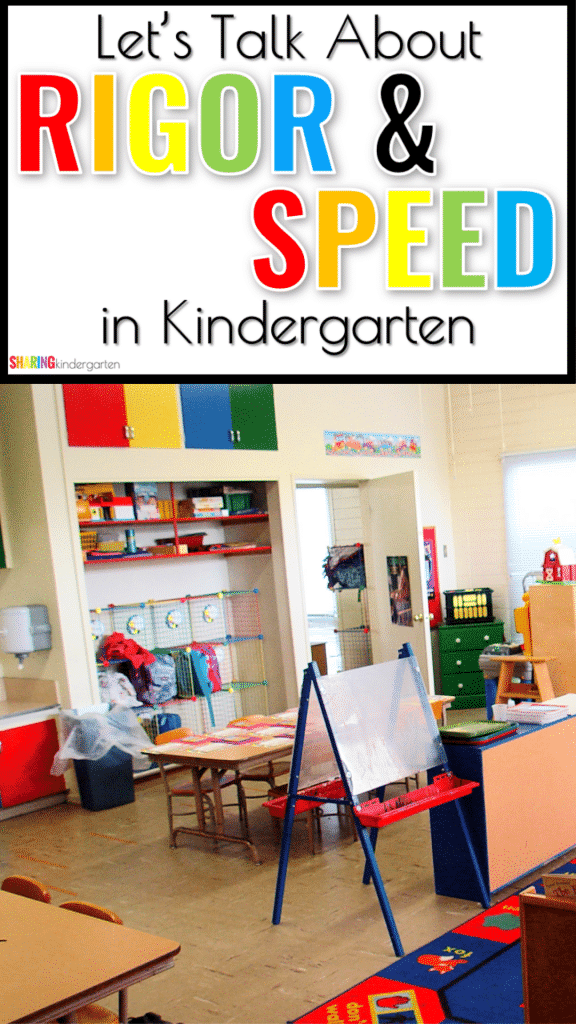
Let’s talk about the difference between speed and rigor in the Kindergarten classroom. There seems to be a big push to move the Kindergarten curriculum faster, more rigorous, and to squeeze in more content. The goal is to get little learners to read more sooner and complete math quicker. Why are we in a hurry? What is the rush?

Let’s Talk About Rigor and Speed in Kindergarten
In recent years, there has been an increased shift in Kindergarten. At first, Kindergarten focused on singing, dancing, and working on social interaction. Currently, Kindergarten focus has shifted towards a classroom that requires sitting, listening, and mastery of some pretty tough standards. Those students who lack a Pre-K experience can enter Kindergarten feeling left behind.
15 years ago, most would enter a Kindergarten classroom to see the painting, art creations, puzzles, kitchens, blocks, building blocks, and so much movement and interaction. Now, people could enter a Kindergarten classroom to see students sitting to do “work” and being pushed to read at certain levels by certain deadlines, write 3 complete sentences about a topic, and so much more.
The Big Question is Why
The big question is why. Many of those lawmakers and curriculum setters are asking for rigor. I guess their response will say how we need rigor to start younger so that students learn sooner, so we can push them further so that when they take these state tests we can prove our students are amazing. Interesting isn’t it?
This leads me to the question- what is rigor? I found the definition of this word so we could look at the exact words and not my interpretation of the word. “Rigorous learning experiences, for example, help students understand knowledge and concepts that are complex, ambiguous, or contentious, and they help students acquire skills that can be applied in a variety of educational, career, and civic contexts throughout their lives.”

What is the difference between rigor and speed in Kindergarten?
One of my pet peeves in education is the blurred line between rigor and speed. Rigor, in my opinion, is digging deep to create a firm understanding of a concept or idea and the ability to use that knowledge in many ways. In many ways, rigor takes time and activities might need to be taught from many angles to allow for a full understanding of the idea. Simply put, a truly rigorous learning experience can not be rushed. Then, speed in educational terms is the rate at which you teach a concept.
For example, do you teach letters of the alphabet in one day, one week, or over and over again from many angles? What is the rate that your students learn beyond the letter and sound, but letter formation and the ability to USE these letters and their sounds? The honest truth about education is that every learner in your room learns at a different rate. One size, one program, and one method can’t and won’t be perfect for everyone.

What does the opportunity cost?
Everything we do in the classroom comes with a cost. Rigorous teaching can very often take time to firmly developed. It also requires students to have the chance to show their skills in many ways. Simply put… rigorous teaching takes time. Students who lack maturity can struggle here. Students who lack background knowledge can also struggle here.
What is the opportunity cost of teaching faster? Most Kindergarten students get this year of growth and exploration once. This is it. What exactly are we rushing?
Should we be pushing to cover letters and sounds quickly? What does this opportunity cost these little learners? We may cover more sounds and phonics rules over time, but does it actually allow all the learners in our room to enter into the zone of rigorous learning? Are we scrapping the surface of understanding for many learners to cover more, faster but missing the big idea of a DEEP understanding of learning? This answer can vary for each learner in your classroom. There isn’t a size-fit answer.
Can I also add something significant that we can’t overlook? What will happen to student behaviors with OR without rigor? Ask yourself the same question about speed.
What is the opportunity cost of a slow-placed curriculum?
To be fair, let’s also discuss what is the cost of a slow-paced curriculum. The educational pendulum has swung away from a letter a week. This seems to be a growing “no” trend in education. Why teach a letter slowly over time when some of your learners know that letter? Why move slowly when others are ready to move on? Your high learners may be bored and ready for more. They got it on Monday and they still have it on Friday. We need these students to read MORE, at a higher level, as soon as possible.

Can’t there be a balance?
When discussing Rigor and Speed in Kindergarten, we have to discuss balance. Here is what I think is the key to ensuring the success of all the learners in your classroom… balance. Easier said than done, right? Balance is what we need for our learners. First, we need some of both rigor and speed. Then, we need to push students who are ready and support those who are not. Next, we need to weigh the opportunity cost of big decisions to make sure that we are meeting the needs of those in our room. Finally, we should provide structured learning and opportunities to learn through play. This can and SHOULD look different in many rooms. We want our learners to grow and we should be nourishing this growth.





I’ve read numerous articles expressing the same concept. I’ve been involved with kindergarten education for almost five decades. I’ve seen no gains in the recent so called push down curriculum. Real early educators know our curricula should be flexible enough to accommodate all learners. We are doing more harm than good by not providing our most vulnerable students with a developmentally appropriate kindergarten program. Bring back play, painting, block building, and open ended projects that integrate content areas a and bring more meaningful experiences to our kindergartners. Let’s stop talking about it. Let’s do something!!